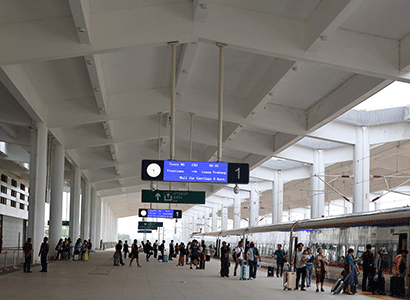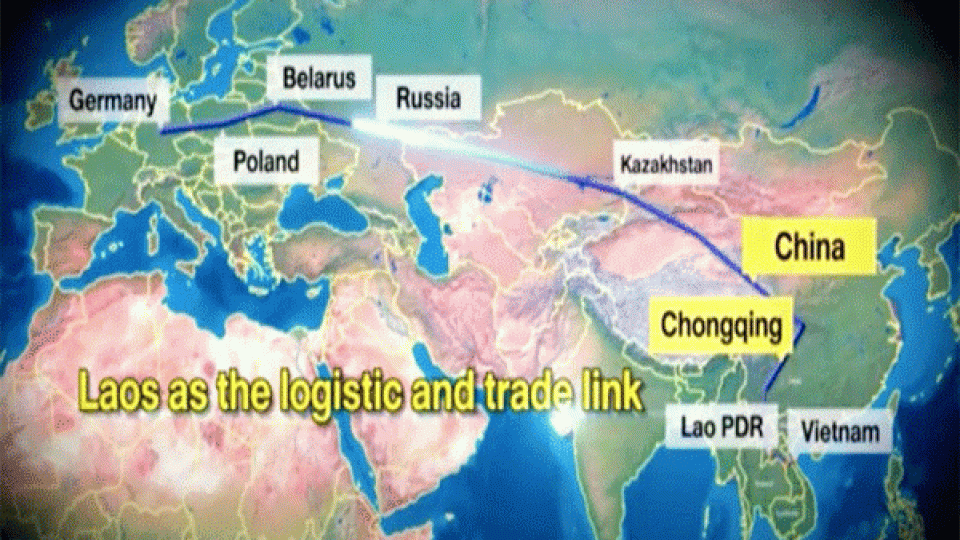August 6, 2024
VIENTIANE – Rail network ‘a game changer for Laos, region looks set to reap benefits’
On a morning trip on a high-speed train departing Vientiane, the capital of Laos, heading north, Vongthong Somphavath, a resident of the world heritage town of Luang Prabang, said she can now enjoy making round trips to the capital and beyond within a day, unlike before, thanks to the Laos-China Railway.
Now aged 27, Vongthong reminisced about her childhood when visits to other parts of the country were rare due to the treacherous and time-consuming mountain roads. Her story is not unique, but shared by many people living in the north.
“It was not just a month, or months; it could be a year or more before we got the chance to visit Vientiane,” Vongthong recalled.
Fortunately, this kind of story has become a thing of the past since December 3, 2021, when the Laos-China railway came into service after full-scale construction began in 2016. It now takes just approximately two hours to travel from Vientiane to Luang Prabang and another two hours to reach Boten in Luang Namtha province that borders China, compared to at least eight and fifteen hours respectively by road.

Passengers board a train in Vientiane heading to northern Laos and onto Kunming in China. PHOTO: VIENTIANE TIMES
Landlocked to land link
The railway – part of the Belt and Road Initiative proposed by China in 2013 – has alleviated landlocked Laos’ transport challenges, unlocking its potential as a transit hub for the region and beyond.
Spanning 1,035 kilometers connecting Vientiane to Kunming in China, the Laos-China railway is integrating into the Trans-Asian Railway, enabling trains to carry freight from Southeast Asia to China and onwards to Kazakhstan, Russia, Belarus, and Poland before reaching Duisburg in Germany. It takes just 14-21 days from Southeast Asia to Europe by rail, compared to 45 days by sea.
“The railway has become an important trade gateway between China and ASEAN,” Head of Office at the Lao Ministry of Public Works and Transport, Saleumsak Sayamoungkhoun told Chinese and Southeast Asian media personnel during their recent eight-day 2024 ASEAN Media “China-Laos Railway Tour”, starting a journey from Vientiane to Kunming.
While waiting for the standard-gauge Laos-China railway to link up with Thailand, Malaysia and Singapore’s tracks to form a broader pan-Asian network linking Kunming to Singapore, the region has already been benefiting from the current system, which seamlessly converges the standard and one-metre gauges. Recently, ASEAN Express – a freight train system linking Malaysia to Thailand, Laos and Chongqing in China – completed its first round trip. Carrying 20 wagons loaded with containers, the freight train departed Selangor in Malaysia on June 27 passing through Bangkok in Thailand before crossing the Mekong river and entering Laos.
At the Thanaleng Dry Port, Laos’ integrated logistics centre in Vientiane, containers were offloaded from the train on the one-metre gauge Laos-Thailand railway onto a train on the 1.435 metre-gauge Laos-China railway running northwards to Chongqing, taking just nine days for a one-way journey compared to 14 to 21 days by sea, resulting in approximately 20 percent cost savings.

Containers are offloaded from a freight train on the one-metre gauge Laos-Thailand railway to a train on the standard-gauge Laos-China railway. PHOTO: THANALENG DRY PORT/VIENTIANE TIMES
With closer links, entrepreneurs already active in Thailand, Laos and China appear to be early birds, reaping the benefits of regional integration.
In April 2023, the Pan-Asia Silk Road Company and its partners including China Railway Express Co., Ltd., Guangzhou Communications Investment Group Co., Ltd., Laos-China Railway Company Limited, Shenzhen Eternal Asia Supply Chain Co., Ltd., Vientiane Logistics Park, State Railway of Thailand, PTT Public Company Limited, Global Multimodal Logistics Company Limited, Kaocharoen Train Transport Company Limited, O Company Oriental Merchant Express Co., Ltd. and Asia Express Logistics Co., Ltd. jointly launched the first freight train carrying 25 reefer containers of durian from Map Ta Phut, Thailand’s largest industrial complex in Rayong province, passing through Laos on the way to Guangzhou in China. Travelling over a distance of 3,453km, the train took just five days to arrive at its destination. The journey from Map Ta Phut to Kunming takes 3-4 days, and from Map Ta Phut to Chongqing it takes 4-5 days, which is cheaper, faster and safer. The journey from Thailand’s border province of Nong Khai to Kunming is now shortened to just 15 hours instead of two days by Road R3A.
“Shipment by rail cuts transport costs by 30 percent,” President of Thailand’s Kaocharoen Train Transport Co., Ltd., told the Vientiane Times.
More benefits than expected
Both passenger and freight traffic on the Laos-China railway has exceeded targets with a very-high growth rate, according to Liu Hong, General Manager of the Laos-China Railway Co., Ltd., a joint venture company (in which Laos holds a 30 percent stake and China 70 percent) operating the Lao section of the railway.
In 2023, Laos’ section of the railway alone carried as many as 2.594 million passengers, a year-on-year increase of 85.8 percent. In addition, Laos-China cross-border trains carried 111,000 passengers last year. Freight transport rose to 4.089 million tonnes, a year-on-year increase of 83.1 percent.
Having been in operation for just two and a half years since December 3, 2021, the annual volume of passenger and freight traffic is close to reaching the annual target set for after the first 10 years following the inauguration of the railway. These figures have been set at 3.6 million passengers and 5,000,050 tonnes of freight.
With such strong figures, “We, as the company, are able to repay debts,” said the Deputy General Manager of Laos-China Railway Co., Ltd., Anongdeth Phetkaysone, referring to debt that financed the Lao section of the US$5.9 billion project.
Opportunity, not debt trap
President Thongloun Sisoulith told NIKKEI Asia in May 2023 in Tokyo that the railway has bolstered Laos’ efforts to transform the country from land-locked to land-linked, sparking hope for driving socioeconomic development, and that it is definitely not a debt trap.
“We have been hearing rumors about this ‘debt trap,’ and I just want to clarify that this is not the reality that is facing our country,” the Lao leader was quoted as saying, adding that Lao people are proud of the nation’s first high-speed railway.
It “has contributed immensely to our economy and will certainly provide a very better future for us.”
A lecturer at Thailand’s Chulalongkorn University, Dr Piti Srisangnam, told the Trader KP News Channel that the Laos-China railway is far more profitable than to be categorised as a ‘debt trap’, given that freight volume – the railway’s main revenue source – in 2023 doubled the break-even point (the point at which total cost and total revenue are equal) of two million tonnes a year.
“This project is the opposite of the debt trap status. It is an important source of foreign currency flowing into Laos,” said Piti, who holds a Ph.D. degree in Economics and Commerce from the University of Melbourne, Australia, and has been teaching International Economics and ASEAN Studies at the Thai university since 2002.
“To understand this (debt trap) narrative, we must first understand what a debt trap means.”
The lecturer explained that ‘debt trap’ criteria are met when a country (creditor) is well aware that a project is not profitable, but gives away a loan anyway in order to lure another country (borrower) into a debt trap with the purpose of damaging the borrower’s economy.
But, he said, this project cannot be considered such a case because China is not just the creditor, but also a borrower and owner of the project via the joint company for up to 70 percent, which means Laos is responsible for just 30 percent, amounting to just US$1.4-1.6 billion of the US$5.9 billion project.
China is not unwise enough “to invest in a project that will certainly go bankrupt”, said Piti, who is currently Executive Director of the ASEAN Foundation, adding that ensuring profitability is a win-win.
Many observers share this view, justifying that if this BRI’s flagship project is a debt trap and does not prove successful here in Laos, then this global infrastructure project is unlikely to gain support elsewhere.
Industry driver
As Laos becomes an effective land link to regional and global supply chains, investors foresee opportunities, pouring capital into developing and doing businesses in 12 special and specific economic zones (SEZs) across the country, advancing the Lao government’s efforts to drive and sustain growth, and diversify the economy away from heavy dependence on natural resources.
Established in 2010 in the heart of Vientiane, the Vientiane Saysettha Development Zone, part of the broader economic corridor along the BRI, has attracted 150 companies from countries such as China, Thailand, Japan, Malaysia, Singapore, Laos, the United States of America and Switzerland, with combined investment of about US$2.3 billion, creating at least 7,000 jobs for local workers. Companies carrying out manufacturing operations in the SEZ enjoy investment incentives such as tax breaks, low labour costs, and cheap electricity.
Additionally, manufacturers in SEZs enjoy privileged access to major markets in countries that provide exemptions or reductions of import tariffs on goods made in Laos, with an unlimited quota. Approximately 42 countries and territories extend such special treatment to Laos.
Lao business tycoon Chanthone Sitthixay, President of the Vientiane Logistics Park Co., Ltd. – the developer of the Thanaleng Dry Port – is currently turning 327 hectares of infertile land near the first Mekong Friendship Bridge, which connects Laos and Thailand, into a modern logistics park, leveraging Laos’ position as a regional and global connector.
The US$547 million project includes a plant and animal quarantine facility, a tank farm, export processing zone, logistics park, free trade zone, technology and halal hub. The Lao investor is also considering building a landmark shopping centre to tap into the growing tourism industry as high-speed trains bring in more tourists and shoppers.
The recent inauguration of express trains connecting Thailand’s capital of Bangkok with Vientiane is adding significant momentum to the flow of tourists across the region.
Deputy Minister of Information, Culture and Tourism, Mrs Darany Phommavongsa, said the high-speed railway has made a significant contribution to facilitating both domestic and international travel, driving robust growth.
In the first four months of this year, Laos welcomed more than 1.5 million foreign tourists, an increase of about 35 percent compared to the same period last year. Chinese tourists numbered at least 351,000, making China the third largest source of foreign visitors to Laos after Thailand and Vietnam respectively.
In light of this robust growth, Darany added, Laos is striving to develop more tourist attractions, upgrade infrastructure, and improve hospitality services to meet the growing need and maximise benefits from the industry.

Luang Prabang National Musuem is a popular tourist attraction in the world heritage town. PHOTO: VIENTIANE TIMES
Sparking business start-ups
While tens of thousands of young Lao people have found jobs within the growing manufacturing and tourism industries, and even with the railway company, Sinxay Lou foresees opportunities beyond that.
Taking a four-year cookery course at Pu’er University in Yunnan, the teenager plans to open a restaurant in his hometown of Luang Prabang after finishing his course in the next three years, leveraging the booming tourism industry and convenient transport system.
Shortly before Sinxay left home for his studies in China, he opened a coffee shop and left it for his family to operate while he is away.
“I want to add more services to my family business, which has already run a 12-room guesthouse for many years,” said Sinxay, whose father is a tour guide in the world heritage town.
Unlike many other teens seeking to become white-collar professionals, Sinxay dreams of becoming a chef, saying “I want to make our services more comprehensive and deliver professional services, using the professional restaurant and service management skills I am gaining here.”
With the course teaching cookery, management, and chemistry, Sinxay said he is also learning the Chinese language as a bonus that will enable him to better serve Chinese clients.
Driving economic growth
As the railway makes Laos more attractive to investors and creates new jobs, the World Bank projected that the rail network could potentially increase aggregate income in the country by up to 21 percent over the long term.
To achieve this, the bank emphasised that Laos undertake bold policy reforms to facilitate trade, and improve connectivity and the business environment.
“These reforms will be necessary to make the country more attractive as a new investment destination,” it recommended.


